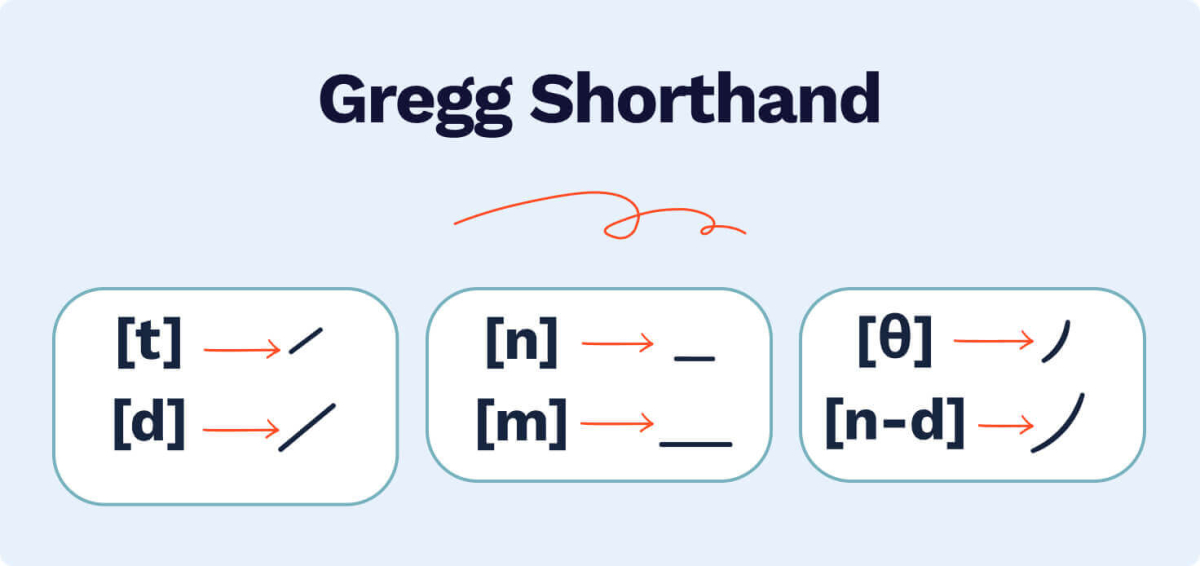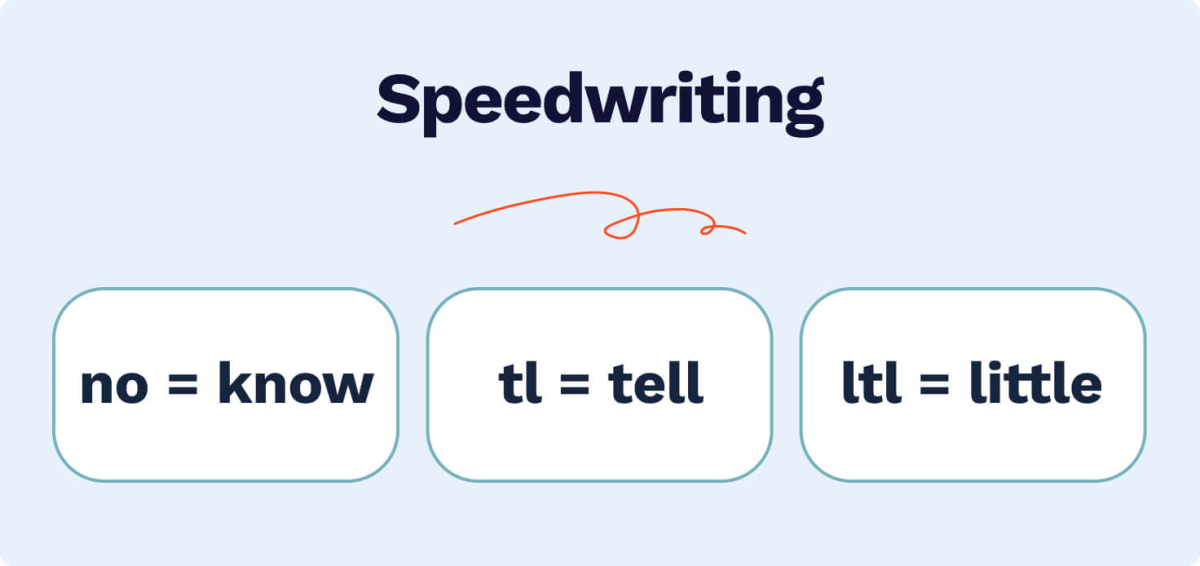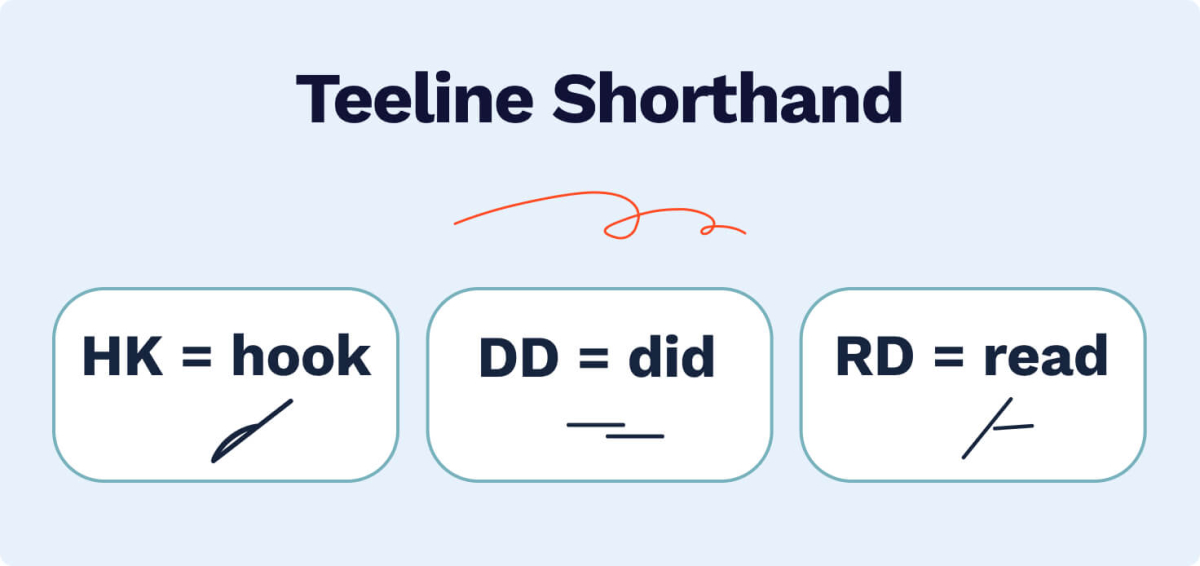While shorthand writing isn’t used today as widely as it was, it is still applicable in fields that require rapid note-taking, such as:
- Stenography
- Journalism
- Business meetings
- Lectures

Though learning shorthand might seem challenging at first, it is feasible if you have a plan and choose the right system. In this guide, you’ll find everything necessary to understand how to write shorthand and how different methods vary from each other. There is also a step-by-step tutorial on how to learn shorthand.
🖋️ What Is Shorthand?
Do you know that Shakespeare’s plays survived the ages because they were written shorthand?
Shorthand implies replacing words, phrases, or letters with symbols or abbreviations to cut down the time required to write down certain information.
Nowadays, shorthand is mainly used to report legal proceedings, record testimony in courts, and note correspondence in business. It is also popular at colleges and universities.
There are four popular types of shorthand:
- Pitman is a British phonographic system. Phonography is writing based on how words sound, ignoring the orthographical rules:
- Del is for deal
- Nif is for knife
- Gregg is an American phonographic system. Just like Pitman, it is only fit for handwriting.
- Speedwriting is based on the alphabet and is suitable for typing:
- Capital C is for ch
- Capital S is for sh
- Teeline is a British system that transcribes spoken words, skipping unnecessary letters.
- CMa is for comma
- LT is for light
📜 The History & Development of Shorthand
Ancient Greece & Rome
We first hear of shorthand in Ancient Greece and Rome.
Xenophon wrote down his memoirs of Socrates in an ancient Greek shorthand system. However, shorthand became commonly used in the Roman Empire. Marcus Tullius Tiro, an educated freedman from Cicero’s house, invented Latin “Tironian notes” in 63 BC. He also compiled a shorthand dictionary. The system was used for the next thousand years.
Julius Caesar, the emperor Titus, and many bishops also used various forms of shorthand. However, at the beginning of the Middle Ages, religious Europe associated it with magic and even witchcraft. This period saw a decline in shorthand practices.
XVII Century
The XVII century arrived, and the Middle Ages became a thing of the past. Four prominent inventors produced new shorthand systems:
- John Willis designed the system that became the prototype for modern shorthand;
- Samuel Pepys used Thomas Shelton’s system in his famous diary;
- Jeremiah Rich popularized the practice by publishing the New Testament in his shorthand;
- William Mason’s method was used to translate the Bible and write down sermons after the Reformation. After some modifications, his system became the official shorthand of the British Parliament.
There were other systems, but most of them didn’t last. The most successful one was invented in 1786 by Samuel Taylor, a British stenographer. It was adapted into Spanish, Portuguese, French, Italian, Dutch, and other languages.
Industrial Revolution
The Industrial Revolution is characterized by the growth of businesses. Commercial relationships require lots of paperwork, so stenographers were in demand. However, business people needed a more straightforward method.
Franz Xaver Gabelsberger produced “Speech-sign art,” a simple cursive system. It used Latin longhand characters. Gabelsberger’s design was so aesthetically appealing and simple to learn and translate that soon it spread to Austria, Scandinavia, Switzerland, and Russia. In 1928, Italy approved it as their national shorthand system.
Pitman
Pitman published his invention in 1837 as Stenographic Sound-Hand. He built upon Taylor’s system but eliminated its drawbacks, incorporating writing by sound. Pitman also advocated for spelling reform. Later, Queen Victoria knighted him for his contributions.
Gregg
John Robert Gregg was 18 when he invented the Gregg shorthand system. When he was 21 in 1888, he published it in England as Light-Line Phonography. In 1893, the first US edition appeared. Surprisingly, it became the most famous American shorthand. It has been adapted into Spanish, Italian, Hebrew, French, Russian, Chinese, and many other languages.
Speedwriting
Emma Dearborn, a professor at Columbia University, invented the system in 1924. She designed it for printing on a typewriter. In 1942, it was adapted for handwriting. Speedwriting is a registered trademark now and is taught in 28 countries.
Teeline
James Hill developed the system in 1968 as a more accessible alternative to Pitman. Now it is used in the Commonwealth of Nations, mainly by journalists. Other Germanic languages (e.g., Swedish and German) adopted it as well.
🚀 5 Reasons Why Shorthand Remains a Vital Skill

1. It is much faster than conventional writing.
Most people pronounce four to five syllables each second. Most words have two to three syllables, making the speech of an average person 100 to 130 words per minute. Professionals can achieve as many as 150 to 160 words per minute. However, traditional letter writing only allows you to take notes at a speed of 20 to 30 words per minute. People can only undertake conventional note-taking at 1/5 the speed of speech.
Shorthand allows you to note 80 to 200 words per minute, depending on the system and the writer’s experience. You can literally note down 100% of what you hear!
2. It does not distract you from listening to the lecture.
Taking conventional notes is similar to taking pictures while traveling. Yes, you collect small pieces of information to recall the details later. But the process is distracting. You look at beautiful vistas through your phone screen, limiting your perception. Similarly, writing down the full text of a lecture limits the volume of information you perceive and understand.
Shorthand is different. You write down everything you hear. And if you do not fully understand something during the lesson, you can review it later. All the necessary information is captured.
3. It makes notetaking easier.
Unfortunately, not all professors care to be listened to and heard. It is a great skill to hold attention, and not everyone has it. Shorthand combines the skills of recording and active listening. Using it helps you stay engaged and take notes even if the speaker leaves a lot to be desired.
4. It helps you catch the main idea.
Not everything you hear in a lecture deserves recording. Summarizing will accelerate your shorthand, especially if you are new to the practice. Shorthand teaches you to summarize and extract patterns out of chaos. When the teacher goes off on a tangent, you can briefly record the central message and take a rest.
Always apply logical thought to what you hear. This approach will save you time when deciphering your shorthand notes.
5. It makes you stand out.
All teachers have their pet students. And with some rare exceptions, these are usually the best students. Shorthand will help you retain more information from each lecture, which will impress your lecturer, help improve your grades and help you stand out in the sea of students.
👣 Learning Shorthand: The 3 Steps
Now that you know why, where, and how different shorthand systems are used and the history of their development, we have prepared a simple three-step methodology to help you learn shorthand. With some training, you can become a real pro!
Step 1: Choose a System
- Pitman is the oldest shorthand type and has gone through several modifications. It is not as popular as other systems.
- Gregg is a newer system based on Pitman because both use phonography. Most professionals consider it more straightforward than its forefather.
- Speedwriting is based on abbreviations and is a conceptually new type. It is the most accessible variant of shorthand.
- Teeline is the most recent system. It has superseded its older prototypes, as it is based on spelling, not pronunciation.
If you need more detail to make your final choice, check out the following information:
Pitman
Pitman created his alphabet based on speech sounds rather than spelling. There are two sets of symbols. One is for consonants, and another one is for vowels. They consist of lines, dots, and slashes.
In particular, unvoiced and voiced sounds (p and b, t and d) are written by strokes with different thicknesses. Unvoiced sounds (p and t) are thin, and voiced ones (b and d) are thick.
It means that you will need a pen with a flexible nib or a pencil responsive to drawing pressure.

You write vowels using light or heavy dashes, dots, or other marks close to the consonant. They are drawn before or over the stroke for the vowels that precede the consonant. Vowel dashes should be placed after or under the stroke for a posterior position.
Pitman 2000, the latest version, has 144 logograms (not too many!). A logogram is a symbol that stands for an entire word or concept.
It used to be the most popular system, although now the following three variants are more widespread.
Pitman: Benefits & Drawbacks
Gregg
The Gregg system emerged 50 years after Pitman as its simplified version and eventually replaced its predecessor. Gregg has a separate set of symbols representing consonants and vowels like Pitman. However, the thickness of dashes is unimportant now, as the size of strokes indicates the length of sounds.

This shorthand is based on elliptical shapes. Logograms take the form of hooks and circles. The Gregg system has a smaller number of logograms than Pitman (only 136), which accelerates the learning process.
Gregg: Benefits & Drawbacks
Speedwriting
Speedwriting is the most advertised shorthand system in America.

The system abbreviates most prefixes and suffixes. For instance, N stands for prefixes enter- or inter-, and “interrogation” is written as “Ntj.” Most common words are also reduced to several letters. Like in many other systems, you can omit some vowels, and in many instances, there is no need to leave spaces between words.
Speedwriting: Benefits & Drawbacks
Teeline
Teeline is the most recently invented shorthand system (1968). In it strokes stand for alphabet letters.

Writing is accelerated by removing unnecessary vowels, double consonants, and silent letters. Special symbols replace compounded letters (sh, ch, ph, etc.). For example, the sentence “You should take notes” is written as, “U shld tk nts.”
Vowel symbols are smaller than consonants: the word “always” is written as aLWys. It is done to save some time and distinguish different sound types.
Teeline: Benefits & Drawbacks
Step 2: Gather Resources
Decide whether you need a printed edition of a training course. It is a good idea to try all available materials on your preferred shorthand system and decide which works best for you.
Pitman Shorthand Resources
Gregg Shorthand Resources
Speedwriting Resources
Teeline Resources
Step 3: Practice
Three factors to consider:
- The difficulty of the chosen system;
- The regularity and duration of your practice;
- The speed you aim for.
In any case, practice makes perfect. No educational video will replace persistent training.
Some key tips:
- Mastery is more critical than speed.
- It is better to practice 30 minutes daily than several hours once a week.
- Divide your learning into stages.
- Once you’ve learned the graphic symbols, increase your speed through shorthand from dictation.
Choose the system that works best for you and start practicing. If you have any questions, experience, or know-how regarding shorthand, please share in the comments below.
